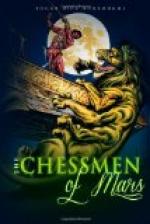Gahan followed with his Odwar’s Panthan one square straight forward, a more scientific move, which opened up an avenue for himself through his line of Panthans, as well as announcing to the players and spectators that he intended having a hand in the fighting himself even before the exigencies of the game forced it upon him. The move elicited a ripple of applause from those sections of seats reserved for the common warriors and their women, showing perhaps that U-Dor was none too popular with these, and, too, it had its effect upon the morale of Gahan’s pieces. A Chief may, and often does, play almost an entire game without leaving his own square, where, mounted upon a thoat, he may overlook the entire field and direct each move, nor may he be reproached for lack of courage should he elect thus to play the game since, by the rules, were he to be slain or so badly wounded as to be compelled to withdraw, a game that might otherwise have been won by the science of his play and the prowess of his men would be drawn. To invite personal combat, therefore, denotes confidence in his own swordsmanship, and great courage, two attributes that were calculated to fill the Black players with hope and valor when evinced by their Chief thus early in the game.
U-Dor’s next move placed Lan-O’s Odwar upon Tara’s Odwar’s fourth—within striking distance of the Black Princess.
Another move and the game would be lost to Gahan unless the Orange Odwar was overthrown, or Tara moved to a position of safety; but to move his Princess now would be to admit his belief in the superiority of the Orange. In the three squares allowed him he could not place himself squarely upon the square occupied by the Odwar of U-Dor’s Princess. There was only one player upon the Black side that might dispute the square with the enemy and that was the Chief’s Odwar, who stood upon Gahan’s left. Gahan turned upon his thoat and looked at the man. He was a splendid looking fellow, resplendent in the gorgeous trappings of an Odwar, the five brilliant feathers which denoted his position rising defiantly erect from his thick, black hair. In common with every player upon the field and every spectator in the crowded stands he knew what was passing in his Chief’s mind. He dared not speak, the ethics of the game forbade it, but what his lips might not voice his eyes expressed in martial fire, and eloquently: “The honor of the Black and the safety of our Princess are secure with me!”
Gahan hesitated no longer. “Chief’s Odwar to Princess’ Odwar’s fourth!” he commanded. It was the courageous move of a leader who had taken up the gauntlet thrown down by his opponent.
The warrior sprang forward and leaped into the square occupied by U-Dor’s piece. It was the first disputed square of the game. The eyes of the players were fastened upon the contestants, the spectators leaned forward in their seats after the first applause that had greeted the move, and silence fell upon the vast assemblage. If the Black went down to defeat, U-Dor could move his victorious piece on to the square occupied by Tara of Helium and the game would be over—over in four moves and lost to Gahan of Gathol. If the Orange lost U-Dor would have sacrificed one of his most important pieces and more than lost what advantage the first move might have given him.




